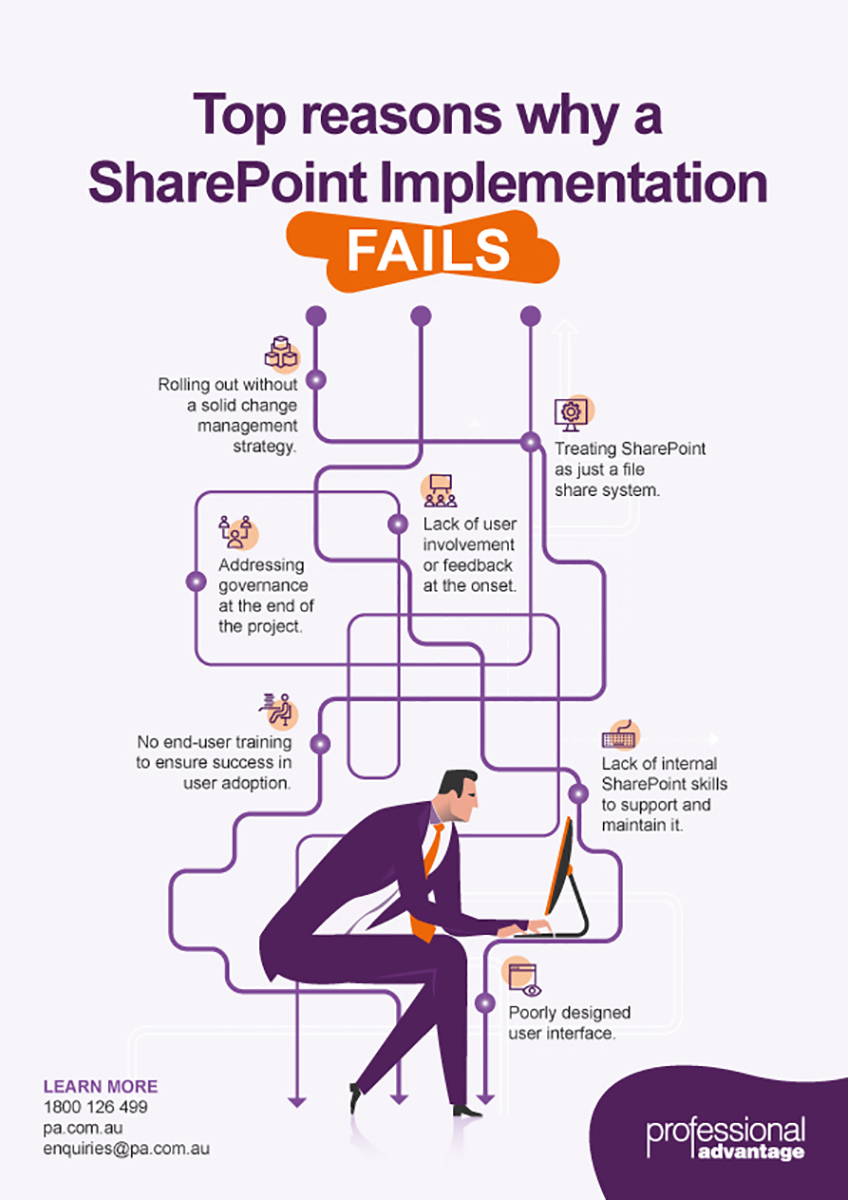Microsoft SharePoint has helped countless organisations modernise their work. You have probably read great reviews, and many of your peers have recommended that your organisation should also jump in the bandwagon, so you have decided to waste no more time and you start exploring SharePoint.
Whilst you can’t wait to get started, you also have doubts about your technical understanding and the complexity of implementing SharePoint. What if you fail to make it work causing money to go down the drain? Or worse, what if nobody uses it at all?
To ensure the success of your SharePoint implementation, we are sharing with you some of the key points behind why it would fail. We have seen and heard these mistakes many times, so hopefully these tips will provide you with the guidance to avoid a SharePoint environment that disappoints.
You can download a high-resolution copy of the infographic here.
Rolling out without a solid change management strategy.
At Professional Advantage, we have met with clients that tried turning on SharePoint without a change management strategy in place, and the result always led to one thing: end-user adoption failure. Resistance to change is an issue you will likely encounter when moving to a new platform, and so a change management strategy is imperative to make a new system work for your users.
A solid change management strategy will give direction and purpose to all of the activities in your implementation process. Identifying the scope, recipients, and the timeline of the change can help you find an approach that will best fit your organisation. Without a solid strategy, you might miss workarounds for potential adoption roadblocks and risks.
Find out how you can have successful change management in just eight-steps in this blog.
Treating SharePoint as just a file share system.
Viewing SharePoint as just an online version of your old file share system is a missed opportunity in itself. You are limiting the capabilities of a multifunctional platform instead of maximising it as a content, communication, and collaboration system.
No file share system can provide the below advantages that SharePoint can:
- Faster data discovery.
- Real-time document collaboration.
- Automate document approvals and various workflows.
- Lets you say goodbye to renaming filenames whenever a new version is made.
- Gives you peace of mind knowing that your files are stored securely in the cloud.
- Accessible on any device, anytime.
- And so much more.
You can even integrate it with other Microsoft applications to automate your complex business processes using Power Apps and Power Automate.
Learn how you can reimagine teamwork by migrating your file shares to SharePoint in this blog.
No end-user training to ensure a successful adoption.
Perhaps the number one indicator for the success of any IT project is end-user adoption. Without it, your users will be left on their own to figure things out, and whilst for some this may work, often it doesn’t. Your end-user training will be essential in 1) explaining to your employees why the change was necessary; 2) educating them on how to use it; and 3) encouraging them to use the new system.
Help your people to build confidence with the new SharePoint solution through practice. During this process, you can also gain their feedback which can help improve your user adoption strategy. Without end-user training, the likelihood of no-one engaging with and using your shiny new intranet is very high.
Discover how to drive SharePoint intranet adoption in this blog.
Lack of internal SharePoint skills to support and maintain it.
Without someone in your IT team with the in-depth experience to monitor and optimise your SharePoint environment, how will you be able to ensure that it is at its peak health and performance level? How will you be able to fully maximise the system’s capabilities without consulting someone with a long history of SharePoint development, deployment, or support experience?
With a SharePoint support partner, you can gain quick access to an expansive team of experts without the need for additional internal headcount, allowing you to draw from their real-world implementation experiences. Support engineers can provide your SharePoint environment with regular health checks to catch irregularities which may cause issues or risks and can help you resolve system errors immediately, even before your users notice a problem.
Read why SharePoint support matters in this blog.
Make your implementation a guaranteed success.
Make your SharePoint implementation a resounding success by consulting with one of our SharePoint specialists at 1800 126 499 or visit our website here.
Can you think of other reasons that lead to SharePoint implementation fails? Comment below, and we’ll share our thoughts on how to address it.








